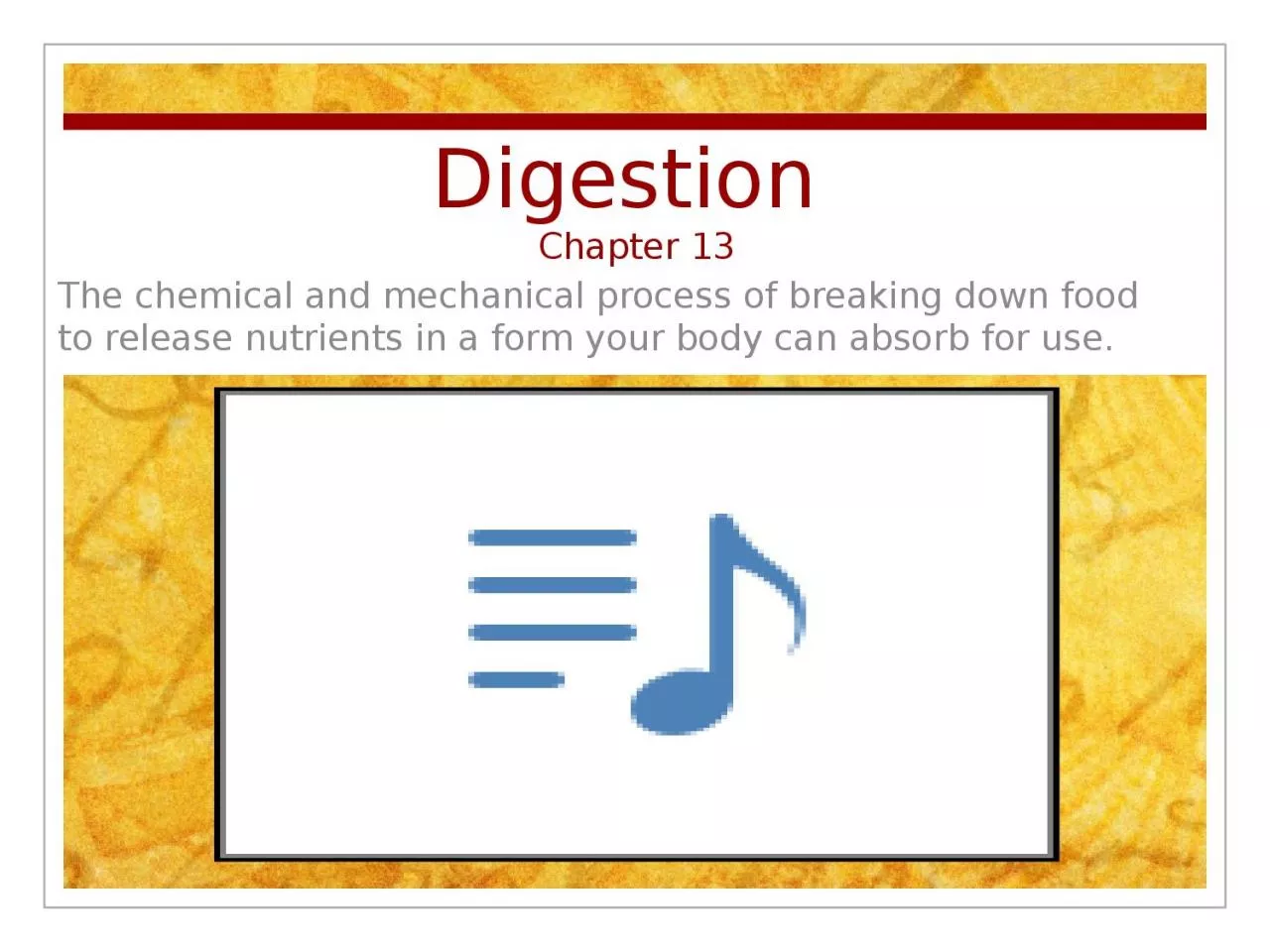

The Digestive System 338 httpwwwyoutubecomwatchvP5lyQUtq1KQ Absorption Food is broken down in the digestive tract or ALIMENTARY CANAL Nutrients get from the digestive tract into the transportation system that carries them to cells throughout the body ID: 1034084
Download Presentation The PPT/PDF document "Digestion Chapter 13 The chemical and ..." is the property of its rightful owner. Permission is granted to download and print the materials on this web site for personal, non-commercial use only, and to display it on your personal computer provided you do not modify the materials and that you retain all copyright notices contained in the materials. By downloading content from our website, you accept the terms of this agreement.
1. Digestion Chapter 13The chemical and mechanical process of breaking down food to release nutrients in a form your body can absorb for use.The Digestive System (3:38)http://www.youtube.com/watch?v=P5lyQUtq1KQ
2. AbsorptionFood is broken down in the digestive tract or ALIMENTARY CANAL.Nutrients get from the digestive tract into the transportation system that carries them to cells throughout the body
3. Digestion in the MouthMastication – the process of chewing the foodSaliva - mixture of water, mucus, salts and digestive enzyme amylase Epiglottis - located at the back of the tongue- prevents food from entering the windpipe
4. Food in the EsophagusEsophagus - tube-like object connecting the mouth to the stomach.Peristalsis – muscular contractions that breaks food down into finer Cardiac sphincter -ring like muscular valve that is at the end of the esophagus.
5. Digestion in the StomachHydrochloric acid – breakdown proteins Enzymes – breakdown proteinGastrin – a protein that controls acid secretionMucus –bicarbonate-rich mucus protects the stomach Chyme – a thick fluid that was once your mealPyloric sphincter – controls the foods rate of movement from the stomach to the small intestine
6. Digestion in the Small IntestineSmall intestine - longest section of the alimentary canalAssisting organs - liver, gall bladder and pancreasLiver - produces bileGall bladder – stores the bile Pancreas - secretes pancreatic juice, an enzyme-rich fluid that continues to reduce food to smaller molecules.
7. Small Intestine AbsorptionNutrients are now tiny molecules that can pass through the thin walls of the small intestineGreatest possible surface area for nutrient absorptionVilli and Microvilli aid the absorption of one particular nutrientFoods are absorbed in a set order, the same order they are broken down. (simple sugars, proteins, fats)
8. Absorption in the Large IntestinesLarge Intestine - colon and rectumBacterial action – breaks down any remaining carbohydrates breaks down indigestible fiber into simpler compounds. Vitamin K and certain B vitamins are created from other existing chemicals.Water Recovery – water is reabsorbed by the body sodium and potassium are also reabsorbedCollection of waste – foods the cannot be used or digested are stored until elimination from the body
9. All about poop!What Your Poop Is Telling You (stop at 10:00)https://www.youtube.com/watch?v=LUHa13nx-uc Bowel Health (stop at 11:00)https://www.youtube.com/watch?v=dxek0D9mH6o